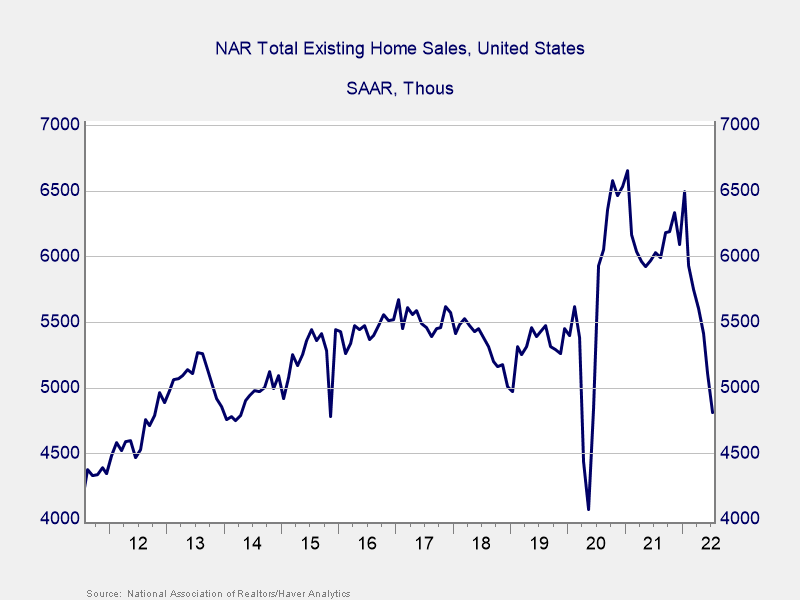Markets Drop on Late-Month Sell-Off
August proved challenging after a late slide caused by rising interest rates dropped all three major indices into the red. The S&P 500 lost 4.08 percent, the Dow Jones Industrial Average (DJIA) dropped 3.72 percent, and the Nasdaq Composite fell 4.53 percent. The sell-off was caused in part by comments from Federal Reserve (Fed) Chairman Jerome Powell, who said the central bank would keep short-term rates higher for longer to combat inflation.
Fundamentals showed improvement. The blended earnings growth rate for the S&P 500 in the second quarter was 7.8 percent, according to Bloomberg Intelligence, beating analyst estimates for a more modest 4.1 percent increase. Technical factors, however, were worrisome. All three indices ended the month well below their 200-day moving averages. This marks five consecutive months with all three finishing below trend, which is a cause for concern because prolonged breaks above or below a 200-day moving average can signal changing investor sentiment.
Concerns about tighter global monetary policy weighed on developed market investors. The MSCI EAFE Index dropped 4.75 percent, while the MSCI Emerging Markets Index eked out a 0.46 percent gain. Both ended August below their 200-day moving averages and have finished below trend every month this year. Fixed income markets also experienced sell-offs. The Bloomberg U.S. Aggregate Bond Index lost 2.83 percent while the Bloomberg U.S. Corporate High Yield Index lost 2.3 percent.
Fed Pumps Brakes on the Economy
July consumer and producer inflation reports showed slowing inflation on a monthly and year-over-year basis, and the Fed’s preferred inflation metric—personal consumption expenditures—declined modestly. Nonetheless, Powell reiterated late last month that the Fed will keep monetary policy tighter until it sees sustained progress in reducing inflation. This signals that rate hikes are likely to continue—even in the face of a slowing economy.
Figure 1. Existing Home Sales, 2011–Present

Source: National Association of Realtors/Haver Analytics
As higher interest rates have started to bite, the economy does indeed appear to be slowing. Business and consumer spending dipped in July, and durable goods orders were flat. Retail sales and personal spending growth also slowed and came in below economist expectations in July. Housing has seen the largest slowdown this year. The average 30-year mortgage rate increased from 3.3 percent in January to 5.95 percent at the end of August. As shown in Figure 1, the pace of existing home sales has slowed notably, from a peak of less than 6.5 million in January to roughly 4.8 million in July.
It’s important to note that the economy remains in a relatively good place. July’s employment report showed that more than 500,000 jobs were added during the month, more than double economist expectations and an encouraging sign that fundamentals remain healthy despite headwinds.
Faster growth could be ahead. Both major measures of consumer confidence showed notable signs of improvement in August, which could bolster future consumer spending and support economic growth. Business confidence also remained in expansionary territory in July, which should support continued hiring. Although we’re likely to see a slower growth economy for the rest of the year, slower growth is still growth, and the momentum from earlier in the year should help us avoid a recession in the near future.
Markets May Face More Turbulence as Uncertainty Remains
The economy may be resilient, but markets remain susceptible. Markets and economists have largely expected higher rates throughout the year, but the August sell-off after Powell’s comments is a reminder that even moderate surprises can lead to short-term volatility. It’s likely the Fed will continue to raise rates throughout this year and the start of next. While the hawkish surprise in August frightened markets, the expectation for higher rates in the short term is now priced in.
The path forward remains cloudy, and more volatility is likely. With most of the potential bad news priced in, however, upside opportunities remain. Given the potential for more market turbulence in the short term, the best strategy is to have a well-diversified portfolio that matches goals with timelines. As always, if you have questions, please contact us to discuss your financial plan.
All information according to Bloomberg, unless stated otherwise.
Disclosure: Certain sections of this commentary contain forward-looking statements based on our reasonable expectations, estimates, projections, and assumptions. Forward-looking statements are not guarantees of future performance and involve certain risks and uncertainties, which are difficult to predict. Past performance is not indicative of future results. Diversification does not assure a profit or protect against loss in declining markets. All indices are unmanaged and investors cannot invest directly into an index. The Dow Jones Industrial Average is a price-weighted average of 30 actively traded blue-chip stocks. The S&P 500 Index is a broad-based measurement of changes in stock market conditions based on the average performance of 500 widely held common stocks. The Nasdaq Composite Index measures the performance of all issues listed in the Nasdaq Stock Market, except for rights, warrants, units, and convertible debentures. The MSCI EAFE Index is a float-adjusted market capitalization index designed to measure developed market equity performance, excluding the U.S. and Canada. The MSCI Emerging Markets Index is a market capitalization-weighted index composed of companies representative of the market structure of 26 emerging market countries in Europe, Latin America, and the Pacific Basin. It excludes closed markets and those shares in otherwise free markets that are not purchasable by foreigners. The Bloomberg Aggregate Bond Index is an unmanaged market value-weighted index representing securities that are SEC-registered, taxable, and dollar-denominated. It covers the U.S. investment-grade fixed-rate bond market, with index components for a combination of the Bloomberg government and corporate securities, mortgage-backed pass-through securities, and asset-backed securities. The Bloomberg U.S. Corporate High Yield Index covers the USD-denominated, non-investment-grade, fixed-rate, taxable corporate bond market. Securities are classified as high-yield if the middle rating of Moody’s, Fitch, and S&P is Ba1/BB+/BB+ or below. One basis point is equal to 1/100th of 1 percent, or 0.01 percent. Authored by Brad McMillan, CFA®, CAIA, MAI, managing principal, chief investment officer, and Sam Millette, manager, fixed income, at Commonwealth Financial Network®. © 2022 Commonwealth Financial Network®





